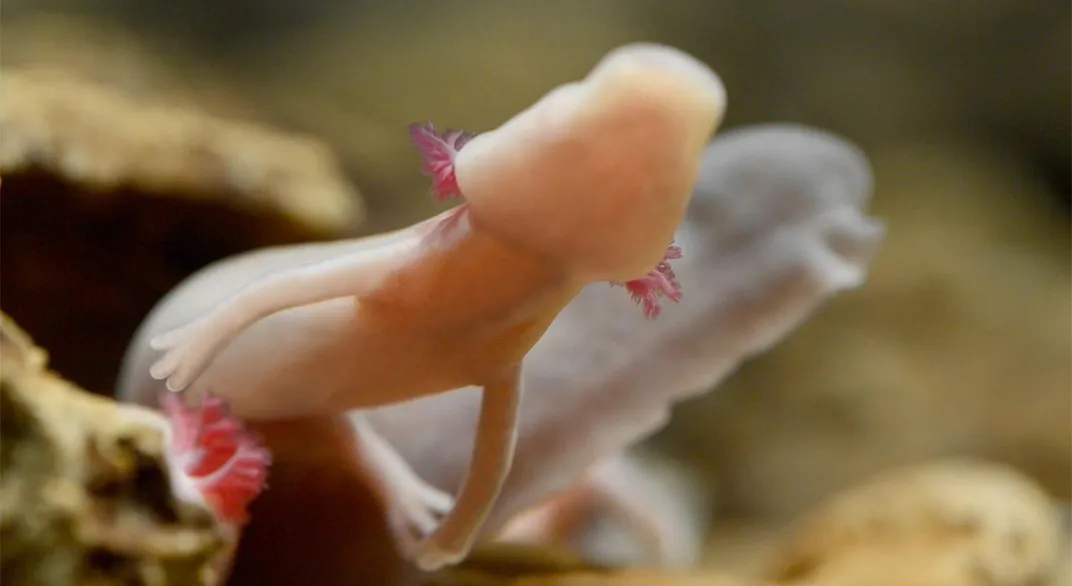A Rare Blind Salamander’s Eggs Are Finally Hatching
Biologists have waited with bated breath for months
/https://tf-cmsv2-smithsonianmag-media.s3.amazonaws.com/filer/a7/c2/a7c2d264-8cec-4fde-9ed0-00861fd22cae/03-jajcece-feb-2016-male-5.jpg)
After four months of waiting and watching, a clutch of eggs laid by a Slovenian salamander called an “olm” are finally hatching. The occasion marks a rare opportunity for biologists to study the species as the salamanders develop into adulthood.
Though olms were discovered in the 17th century, many mysteries surround the species. The pale white salamanders have evolved to survive in total darkness, and for centuries the only glimpse people caught of the strange amphibians was the rare occasion one would wriggle out of their pitch-black habitats, Léa Surugue reports for International Business Times UK. In addition to being rarely seen, olms only breed once every decade or so, making their life cycle hard to study.
"In the wild, we never find eggs or larvae,” zoologist Dušan Jelić told Jonathan Webb for the BBC when the olm laid her clutch of eggs in Slovenia’s Postojna Cave back in January. “They are probably hidden within some very specific localities within the cave systems."
Olms have long held a place in Slovenian folklore, as their odd appearance and frilly pink gills led some to believe the olms were infant dragons. To this day, the olms are nicknamed “baby dragons,” Surugue writes. However, the blind salamanders do sport some pretty fantastical abilities – scientists have shown that olms can go as long as a decade without feeding, and some believe that they can live for as long as a century.

"This is very cool—it is quite extraordinary," Primoz Gnezda, another biologist working at Postojna Cave, told Webb in January. "But also, we are quite scared that something will go wrong, because the eggs are very sensitive."
This is the first time an olm at Postojna Cave has laid eggs since 2013. The eggs from that clutch were eaten by another olm, and none survived. This time, biologists separated the fragile eggs from their elders and have kept them under constant watch via infrared camera, Webb writes. Luckily, when the first egg hatched earlier this week, the exciting moment was caught on tape.
"I was in the cave doing some other biological work,” biologist Sašo Weldt tells Webb. “Since we have all the eggs on an IR camera, we saw that one was missing. Then you rewind and suddenly you realise, something has happened."
So far, one of the 23 eggs has fully hatched, with another still wriggling away. The scientists hope that over the next few weeks they will see the whole clutch make their way out into the world to begin their slow growth into adulthood. Since the mother olm laid her eggs, Slovenian researchers have been working closely with French scientists from an underground lab in Ariege, France, where scientists have studied the salamanders since the 1950s, Webb writes. So far, that is the only other site where baby olms have been observed hatching from their eggs.
"In the cave, in nature, they hatch all the time—but nobody here has ever seen a hatchling younger than about two years," Weldt tells Webb.
The baby olms aren’t out of the water yet, so to speak.
The eggs and hatchlings alike are very delicate, and the scientists plan on keeping a close watch on them to make sure as many as possible survive. Even the eggs that have survived so far make up just a fraction of the clutch, as the mother originally laid 64. Of those, only 23 embryos developed, while the rest were unfertilized or were destroyed by fungal infections. Even now, anything can happen to the emerging olms. Regardless, Weldt tells Webb that the strange salamanders have a much better chance of surviving than their wild cousins.
"In nature, out of 500 eggs let's say, two adults may arrive," Weldt says.